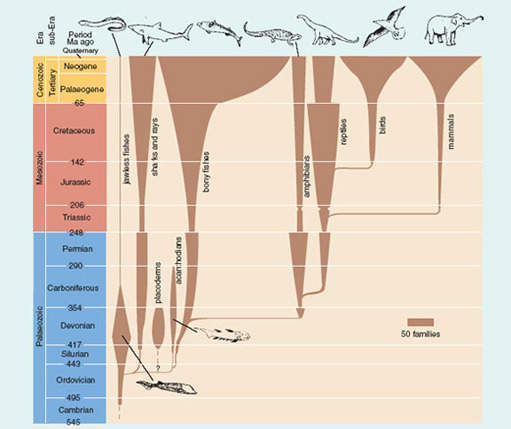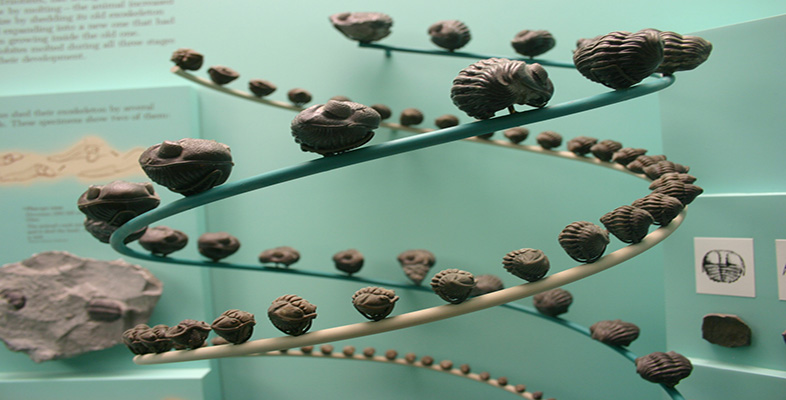6.2 An outline of vertebrate evolution
Let's now place the early evolution of tetrapods in perspective by taking an overview of the whole of vertebrate evolution.

Click to view printable version of image
View document [Tip: hold Ctrl and click a link to open it in a new tab. (Hide tip)]
Given the ubiquity of our own primate species, and familiarity with domesticated animals such as cats, dogs, and rabbits, our view of the relative diversity and abundance of the main vertebrate groups tends to be biased towards mammals. However, a tally of living vertebrate species reminds us that mammals are not as dominant as some might imagine. In round terms, the total number of living vertebrate species is over 66 000 (which compares, for example, with some 110 000 species of molluscs and more than 80 000 species of roundworms (nematodes)). Living mammals number around 6000 species, and amphibians around 8000 species, whereas there are some 12 000 reptile species, 11 000 bird species and over 28 000 species of bony fish, and about 800 species of sharks and rays, the cartilaginous fish. (You may want to look up the latest figures online as you read this section, as these numbers are constantly refined.)
SAQ 19
Which of today's five vertebrate classes (Section 1.3) were in existence by the end of the Triassic Period (see Figure 14)?
Answer
Fishes, amphibians, reptiles and mammals had all evolved by then, about 206 Ma ago.
SAQ 20
In terms of families, which living vertebrate groups shown in Figure 14 are at their highest diversity today? Which living groups were more diverse in the past, and when was their peak of diversity?
Answer
Sharks and rays, bony fishes, birds and mammals are at their maximum family diversity today. Jawless fish were most diverse in the Devonian; amphibians in the Permian; and reptiles in the Cretaceous.
In discussions such as this, it is important to be aware which taxonomic category (e.g. order, family or genus) is being considered because the picture can change if other measures of diversity (e.g. species) are used.
Activity 1
From Figure 14, estimate roughly (to the nearest five) the number of living families of reptiles and of mammals. Then, using the data on species numbers given above, work out which of these two groups has, on average, more species per family.
Answer
Figure 14 shows approximately 40 families of living reptiles. So the average number of species per family is 12 000 divided by 40 ≈300. There are about 150 families of living mammals and 6000 species, giving an average of 6000 divided by 150 ≈40. Thus living reptiles have far more species per family than mammals.
As we have already seen, the vertebrates were initially slow to diversify. From their Cambrian start, it was not until late Ordovician times that the early jawed fish evolved into different groups, though some were subsequently to become extinct (the placoderms, see Atlas, pp. 76-77, and acanthodians, see Atlas, p. 83). From Figure 14 it becomes clear why the Devonian is often called the 'Age of Fishes': not only was there a greater diversity of fish groups than at any other time but most of the other vertebrate classes had yet to evolve.
Figure 14 reveals a variety of patterns in fish evolution, including some major setbacks. The placoderms became extinct at the end of the Devonian, coincident with a decrease in early tetrapod diversity. Sharks, rays and bony fishes suffered a major extinction at the end of the Permian, coincident with a similar setback for amphibians and reptiles, part of a mass extinction event. Today, the total number of fish families is at its highest ever, mainly due to the bony fishes.
SAQ 21
When did the total number of bony fish families begin to increase steeply from some 95 families to their present total of about 260?
Answer
In early Tertiary (Palaeogene) times.
Let's now look at the history of tetrapods. After emerging in late Devonian times, tetrapod communities were initially dominated by amphibians, especially in Carboniferous and Permian times, when a wide variety of amphibian groups evolved and died out. Amphibians remained large during the Palaeozoic Era, often 1-2 m long - huge by the standards of today's frogs, toads and newts, which have a relatively recent, Mesozoic origin. The first reptiles appeared in the early Carboniferous.
SAQ 22
What crucial adaptation did reptiles evolve that freed them from the amphibian dependence on being near water to lay eggs and develop tadpoles?
Answer
A shelled egg that did not dry out in air (the amniotic egg) (Section 6.1).
At first the earliest Carboniferous reptiles were quite small, superficially lizard-like predators. They lived mostly on arthropods, such as dragonflies and cockroaches, in the dense equatorial Carboniferous forests and swamps. The energy of sunlight trapped during photosynthesis became stored in vast amounts of plant litter that accumulated on the floor of the forests and in swamps. Eventually, this debris was buried, compressed and converted by heat and pressure into coal; 300 Ma later the energy from Carboniferous sunlight fuelled the Industrial Revolution.
Not until Permian times did reptiles begin to diversify widely and increase in size; some even returned to living in the sea. Others evolved certain mammal-like features, such as the beginnings of tooth differentiation. This allowed for separate functions such as large dagger-shaped teeth for defence and killing prey, and smaller cheek teeth for efficient processing of food before digestion. One of these groups that survived the end Permian mass extinction eventually evolved into the first mammals in the late Triassic.
Activity 2
Using Figure 14, measure the approximate number of families (to the nearest five) present in the four main vertebrate groups (sharks and rays, bony fishes, amphibians and reptiles), first at the end of the Permian and then in the early Triassic. From these totals, calculate the percentage change in family diversity.
Answer
The approximate numbers of end Permian families are: sharks and rays (20), bony fishes (25), amphibians (35) and reptiles (20) - total 100. Early Triassic families: sharks and rays (10), bony fishes (10), amphibians (10) and reptiles (5) - total 35. There was therefore a 65 per cent decrease in family diversity across the Permian-Triassic boundary.
After the end Permian extinction event, the reptiles recovered and gradually became the dominant group by the end of Triassic times, though both reptiles and amphibians were set back by another, late Triassic, extinction event.
SAQ 23
Which group do you think was mainly responsible for the dominance of reptiles in the Mesozoic?
Answer
It was, of course, the dinosaurs, though dinosaurs were only one of many kinds of Mesozoic reptiles.
Dinosaurs were a special group of reptiles - special not least because, after their origin in the late Triassic, they became the dominant land animals for over 150 Ma. They filled almost every niche possible for large land vertebrates. They included carnivores, herbivores and a few omnivores (mixed diet), and ranged in size from that of a chicken to vast plant eaters, such as the Brachiosaurus, which grew up to 25 m long and weighed up to 40 tonnes. Dinosaurs never, however, took to the air or to the oceans: other large reptiles - the pterosaurs - dominated the skies, and marine reptiles such as ichthyosaurs, plesiosaurs and mosasaurs flourished in the sea. The major surviving groups of reptiles, the crocodiles, turtles and tortoises, lizards and snakes also all appeared in Mesozoic times. Much evidence suggests that birds evolved from dinosaurs in late Jurassic times.
The great success of the Mesozoic reptiles came to a dramatic halt at the end of the Cretaceous. Reptile diversity was cut back from about 60 families to 30 and never fully recovered (Figure 14). The bony fishes rapidly increased in diversity in the early Tertiary.
For a long time after their late Triassic origin, mammals remained small, perhaps nocturnal, shrew-like creatures living in the nooks and crannies of the dinosaur world. But once the large Mesozoic reptiles had become extinct, mammals were able to diversify into the wide range of niches that became vacant. Plants, which also suffered some extinctions at the end of the Cretaceous, continued to have a role in the evolution of both vertebrates and invertebrates. The rise of flowering plants (angiosperms) and pollinating insects, together with climate change in the early Tertiary, promoted the evolution of grasses, which in turn supported the spectacular rise of grazing mammals. It was perhaps the climate-driven change in vegetation that promoted our own evolution from tree-dwelling primates in late Cenozoic times. Global cooling as part of the initial descent into the Quaternary Ice Age caused retreat and fragmentation of the extensive forests of central Africa and their replacement by more open grasslands. This gave an adaptive advantage to a group of more upright-walking primates - the hominids. Our own species, Homo sapiens, appeared only 100 000 to 150 000 years ago (depending on how the origin of the species is defined).
